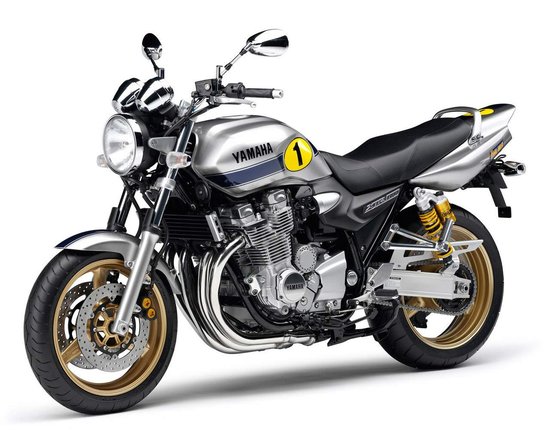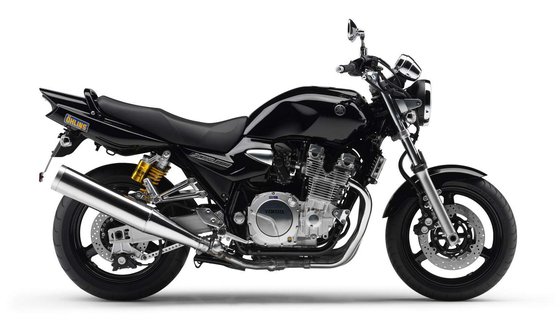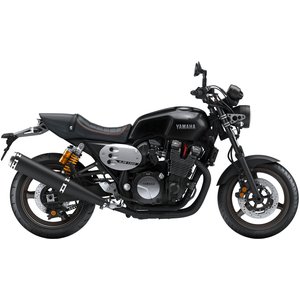Yamaha XJR 1300 (2007–2009): A Retro Muscle Bike That Refuses to Grow Old

Introduction
The Yamaha XJR 1300 is a motorcycle that defies trends. Born in an era when liquid-cooled engines and digital rider aids began dominating the market, this air-cooled brute chose to double down on raw, analog charisma. The 2007–2009 iteration of the XJR 1300 represents a refined version of Yamaha’s “big naked” philosophy—a bike that blends old-school muscle with just enough modern tweaks to stay relevant. After spending a day with this machine, it’s clear why it still commands a cult following. Let’s dive into what makes this generation of the XJR 1300 a timeless ride.
Design: Retro Styling Meets Functional Aggression

The XJR 1300’s design is a masterclass in balancing nostalgia with purpose. Its steel double-cradle frame, exposed engine block, and minimalist bodywork scream 1990s muscle, but subtle updates keep it from feeling dated. The 2007 refresh introduced sharper side covers, a redesigned seat with improved stitching, and LED taillights that add a modern flicker to its retro silhouette.
The riding position is classic upright naked bike: wide handlebars sit at a comfortable height, the seat is plush yet supportive (820 mm / 32.2 in), and the 21-liter (5.5 US gal) teardrop fuel tank gives your knees something to grip during aggressive throttle twists. The dashboard is refreshingly simple—analog gauges for speed and RPM, with a small digital display for odometer and trip data. At 2,175 mm (85.6 in) long and 240 kg (529 lbs) wet, it’s no featherweight, but the weight carries a certain authority that suits its character.
Engine & Performance: Torque Is the Name of the Game

At the heart of the XJR 1300 lies a 1,251 cc air-cooled inline-four engine—a configuration that’s nearly extinct in today’s emissions-conscious world. This isn’t a high-revving screamer; it’s a torque monster. With 108 Nm (80 lb-ft) peaking at just 6,000 rpm and 106 hp (77 kW) on tap, the XJR thrives in the real world. Throttle response is immediate thanks to the fuel injection system introduced in this generation, a significant upgrade from earlier carbureted models.
The 4-2-1 exhaust system with a catalytic converter gives the bike a throaty, resonant growl that’s subdued at cruising speeds but erupts into a baritone roar when pushed. Acceleration is relentless from 3,000 rpm onward, with a surge that pins you to the seat without ever feeling frantic. The 5-speed transmission is clunky by modern standards—shifts require deliberate footwork—but it suits the bike’s unapologetically mechanical vibe.
Handling: Surprisingly Nimble for a Beast
Don’t let the XJR’s bulk fool you. The Öhlins rear suspension (a premium addition for this generation) and revised front fork settings give it a planted yet agile demeanor. At low speeds, the 1,500 mm (59 in) wheelbase and 222 kg (489 lbs) dry weight demand some muscle in parking lots, but once moving, the bike feels surprisingly light.
The steering is neutral, and the Bridgestone Battlax tires (120/70-ZR17 front, 180/55-ZR17 rear) offer ample grip for spirited cornering. Where the XJR truly shines is stability. At highway speeds, it tracks like a train, unfazed by crosswinds or rough pavement. The suspension soaks up bumps without wallowing, though hardcore canyon riders might crave adjustable damping. Braking is confident with dual 298 mm front discs and 4-piston calipers, though the rear 245 mm disc feels underwhelming for emergency stops.
Competition: How Does It Stack Up?
The XJR 1300’s closest rivals in the 2000s naked bike segment were the Honda CB1300 Super Four, Suzuki Bandit 1250, and Kawasaki ZRX1200. Here’s how it compares:
- Honda CB1300 Super Four: Honda’s offering matched the XJR’s displacement but prioritized smoothness over raw torque. The CB’s liquid-cooled engine felt more refined but lacked the XJR’s visceral character.
- Suzuki Bandit 1250: The Bandit was lighter and cheaper, with a liquid-cooled engine that delivered similar power. However, its budget suspension and plasticky build quality couldn’t match the XJR’s premium feel.
- Kawasaki ZRX1200: The “Eddie Lawson” replica ZRX had retro styling to rival the XJR and a lively engine. Yet, its carbureted setup felt outdated next to Yamaha’s fuel-injected torque curve.
The XJR 1300 carved its niche by combining air-cooled authenticity with modern upgrades. It’s less polished than European rivals like the Ducati Monster S4R but far more accessible to wrench on.
Maintenance: Keeping the Legend Alive
Owning an XJR 1300 is a commitment to old-school mechanics—but a rewarding one. Here’s what to watch:
- Valve Adjustments: The DOHC engine requires valve clearance checks every 26,000 km (16,000 mi). Intake valves should be 0.11–0.15 mm (0.004–0.006 in), exhaust 0.16–0.20 mm (0.006–0.008 in).
- Oil Changes: Use 10W-40 oil (3.2 liters / 0.85 US gal with filter). The air-cooled engine runs hot, so frequent changes (every 5,000 km / 3,100 mi) are wise.
- Carb Sync (Post-2007): While this generation uses fuel injection, earlier XJRs needed carb balancing—a task this model avoids.
- Chain Care: The 110-link chain demands regular lubrication. Consider upgrading to an X-ring chain for longevity.
- Tire Pressure: Yamaha recommends 2.5 bar (36 psi) front and rear, or 2.9 bar (42 psi) rear for two-up riding.
Pro Tip: The stock exhaust is heavy and restrictive. A slip-on aftermarket system (available at MOTOPARTS.store) shaves weight and unlocks the engine’s full acoustic potential.
Conclusion: A Love Letter to Analog Motorcycling
The Yamaha XJR 1300 (2007–2009) isn’t just a motorcycle—it’s a statement. In a world increasingly dominated by touchscreens and ride modes, this bike reminds us why simplicity matters. Its air-cooled engine thrums with soul, its suspension handles backroads and highways with equal poise, and its design ages like a fine leather jacket.
Is it perfect? No. The weight, the basic suspension, and the thirst for premium fuel (21 liters / 5.5 US gal) are compromises. But these quirks are part of its charm. For riders who crave a machine that feels alive under them, the XJR 1300 delivers in spades. And when it’s time to personalize or maintain your ride, MOTOPARTS.store has the parts to keep this legend roaring for decades to come.
Specifications sheet
| Engine | |
|---|---|
| Stroke: | Four-stroke |
| Ignition: | Digital TCI |
| Max power: | 77 kW | 103.0 hp |
| Max torque: | 108 Nm |
| Fuel system: | Fuel Injection (SDTV 39 mm) |
| Lubrication: | Wet sump |
| Max power @: | 6000 rpm |
| Displacement: | 1251 ccm |
| Max torque @: | 6000 rpm |
| Configuration: | Inline |
| Cooling system: | Air/Oil-cooled |
| Compression ratio: | 9.7:1 |
| Number of cylinders: | 4 |
| Dimensions | |
|---|---|
| Wheelbase: | 1500 mm (59.1 in) |
| Dry weight: | 222 |
| Wet weight: | 240 |
| Seat height: | 795 mm (31.3 in) |
| Overall width: | 765 mm (30.1 in) |
| Overall height: | 1115 mm (43.9 in) |
| Overall length: | 2175 mm (85.6 in) |
| Ground clearance: | 125 mm (4.9 in) |
| Fuel tank capacity: | 21 L (5.5 US gal) |
| Drivetrain | |
|---|---|
| Final drive: | chain |
| Chain length: | 110 |
| Transmission: | 5-speed |
| Rear sprocket: | 38 |
| Front sprocket: | 17 |
| Maintenance | |
|---|---|
| Rear tire: | 180/55-z-17 |
| Engine oil: | 10W40 |
| Front tire: | 120/70-z-17 |
| Idle speed: | 1070 ± 100 rpm |
| Brake fluid: | DOT 4 |
| Spark plugs: | NGK DPR8EA-9 or NGK DPR8EIX-9 |
| Spark plug gap: | 0.9 |
| Forks oil capacity: | 1.03 |
| Engine oil capacity: | 4.2 |
| Engine oil change interval: | Every 5000 km or 2 years |
| Valve clearance (intake, cold): | 0.11–0.15 mm |
| Valve clearance (exhaust, cold): | 0.16–0.20 mm |
| Recommended tire pressure (rear): | 2.5 bar (36 psi) solo, 2.9 bar (42 psi) with passenger |
| Recommended tire pressure (front): | 2.5 bar (36 psi) |
| Additional Features | |
|---|---|
| Lighting: | LED taillight, illuminated meter panel |
| Exhaust system: | 4-2-1 with 3-way catalytic converter |
| Adjustable handlebar position: | True |
| Chassis and Suspension | |
|---|---|
| Rake: | 25.0° |
| Frame: | Steel double cradle |
| Trail: | 100 mm (3.9 in) |
| Rear brakes: | Single 245 mm disc, 2-piston caliper |
| Front brakes: | 2 x 298 mm discs, 4-piston calipers |
| Rear suspension: | Öhlins twin-shock, adjustable spring preload (specialized settings) |
| Front suspension: | Telescopic fork, 43 mm stanchions, coil spring/oil damped |
| Rear wheel travel: | 120 mm (4.7 in) |
| Front wheel travel: | 130 mm (5.1 in) |



















